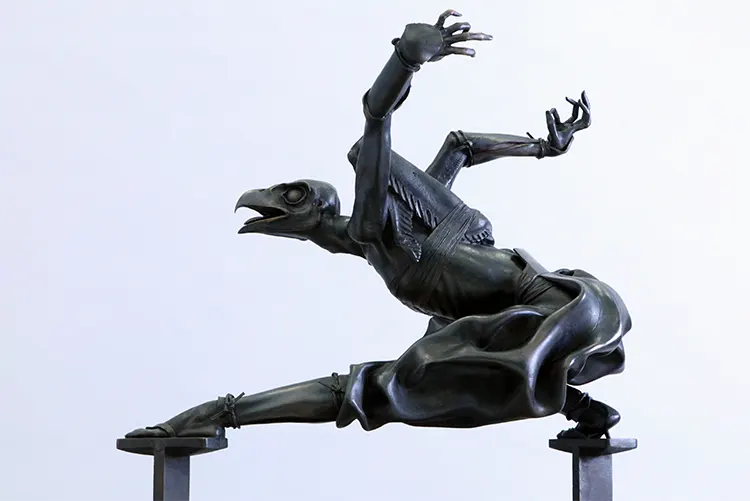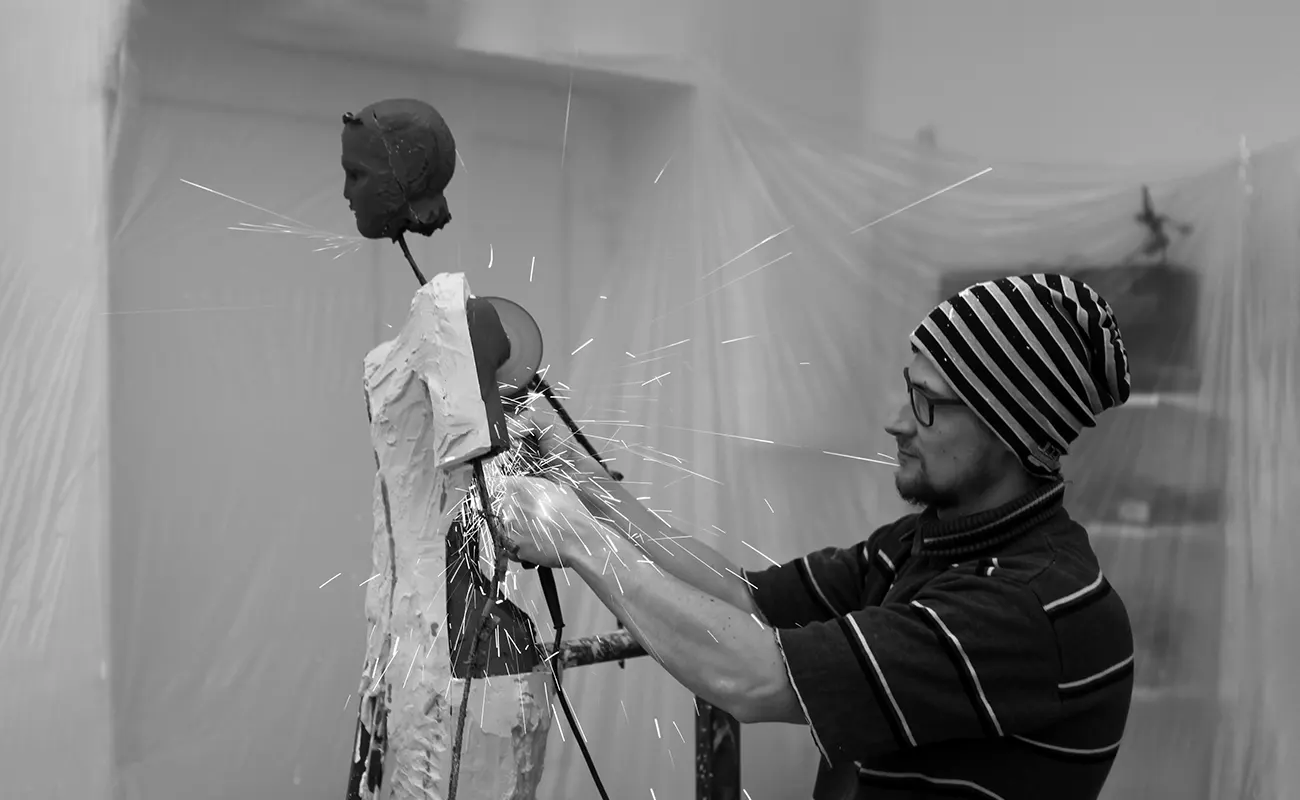“I strive to address contemporary issues through my artworks…in each work, there is a cipher of my inner experience that I undergo at the moment of creation.”
The Sculptor’s Unlikely Path
Pavel Kaltygin‘s journey into the world of sculpture is as unconventional as it is fascinating. Initially drawn to the precision and logic of mathematics, programming, and drafting, Kaltygin seemed destined for a career in architecture. Yet, life had a different script for him. The pivotal moment in his career trajectory occurred when he met his future mentor, who saw a sculptor in the making and nudged him towards the Repin Academy of Fine Arts. This suggestion set Kaltygin on a path of rapid learning, as he had less than a year to acquire the skills necessary for admission, competing against peers with years of sculpture practice behind them. His successful entry into the Academy marked the beginning of an accelerated educational journey that not only honed his artistic skills but also instilled a rigorous work ethic that would define his career.
While at the Academy, Kaltygin didn’t just immerse himself in academic studies; he also worked in his professor’s studio, creating monuments. This hands-on experience with monumental works, coupled with his roles as an assistant professor and a participant in his mentor’s projects, laid a solid foundation for his technical skills and artistic vision. However, it was the decision to part ways with his mentor that truly allowed Kaltygin to explore his individuality as an artist. Embracing independence, he embarked on a journey of personal and artistic discovery, participating in exhibitions and tackling independent projects that would carve his niche in the art world.
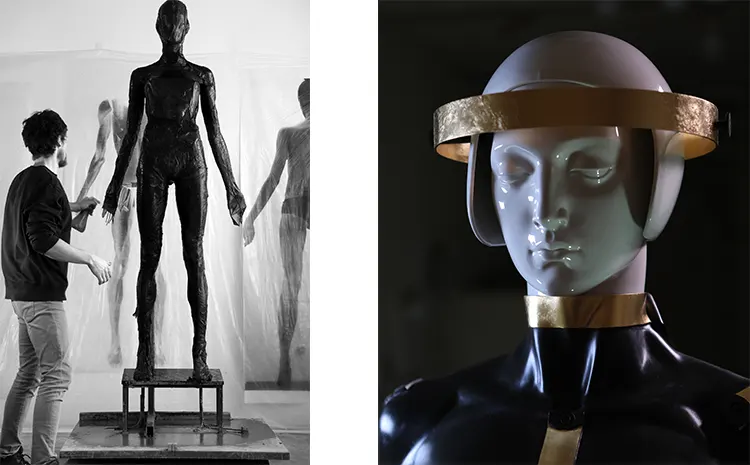
Pavel Kaltygin: Artistic Inspirations and Philosophies
For Pavel Kaltygin, art is more than just an expression; it’s a complex dialogue between the artist and the viewer, imbued with layers of meaning and personal experience. This dialogue is most evident in his “Humans – Animals” series, where anthropomorphic forms serve as a canvas for exploring profound human qualities such as wisdom, faith, power, creativity, and love. By drawing from myths, epics, and legends across various cultures, Kaltygin not only showcases his academic background and meticulous attention to detail but also invites the viewer to engage with universal themes through a contemporary lens. The series, exemplified by works like St. Christopher and Tengu, goes beyond mere depiction, capturing the essence of human experiences and emotions in moments of transformation.
Kaltygin’s approach to creating art is deeply introspective and methodical. He likens his process to building a pyramid of concepts, where each layer narrows down the theme until it culminates in a highly personal interpretation. This methodical approach is evident in how he tackles themes such as faith in the work “Christopher,” where he explores the concept from its broadest implications to a specific examination of religious faith, eventually leading to a reflection on his personal relationship with contemporary religious institutions. This depth of exploration ensures that while the overarching theme may be universal, the artwork itself is distinctly personal, offering a unique perspective that invites multiple interpretations. Kaltygin’s art, therefore, becomes a bridge between the universal and the personal, challenging viewers to see beyond the surface and engage with the layers of meaning embedded within each piece.
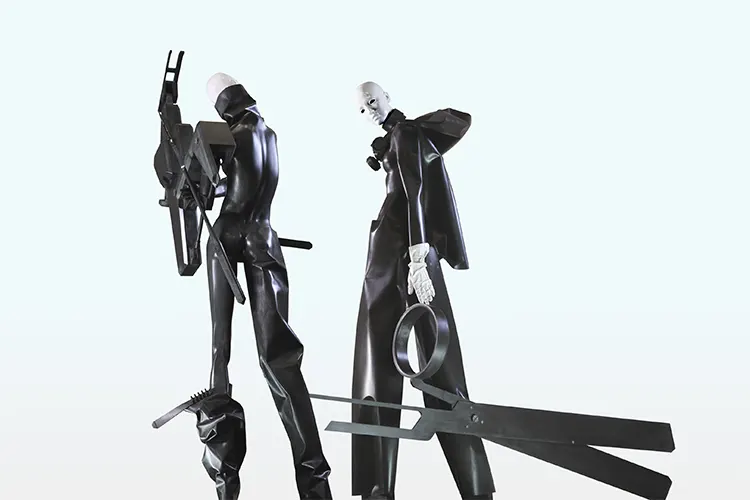
The Sanctity of the Studio
For Pavel Kaltygin, the studio is not just a physical space but a crucible for creativity, where the external world is distilled into artistic vision. Emphasizing a minimalist approach, Kaltygin surrounds himself with only the essentials necessary for his current project, advocating for a white background that serves as a blank canvas for his imagination. This deliberate simplicity allows him to focus intensely on his work, undistracted by the clutter that often fills artists’ workspaces. However, Kaltygin’s engagement with the world outside his studio is equally crucial to his creative process. By dispersing his interests broadly when away from his studio, he gathers a rich tapestry of images and ideas that he then filters through upon his return, ensuring that only those that serve his artistic intent influence his creations. This dynamic between engagement and isolation, between the world and the studio, enables Kaltygin to maintain a fresh perspective, constantly reinvigorating his work with new insights and inspirations.
The tools of his trade are of particular significance to Kaltygin, who describes himself as somewhat of a fetishist when it comes to the instruments of sculpture. From chisels and stamps to hammers, every tool that interacts with his materials is either handcrafted or meticulously chosen and adapted for his specific use. This intimate relationship with his tools underscores the tactile nature of sculpture, where the physical act of creation is as meaningful as the conceptual underpinnings of the work itself. Kaltygin’s studio, therefore, is more than just a workspace; it is a sanctuary where materials, tools, and artist converge in the act of creation, each element carefully chosen and arranged to facilitate the transformation of raw materials into art.
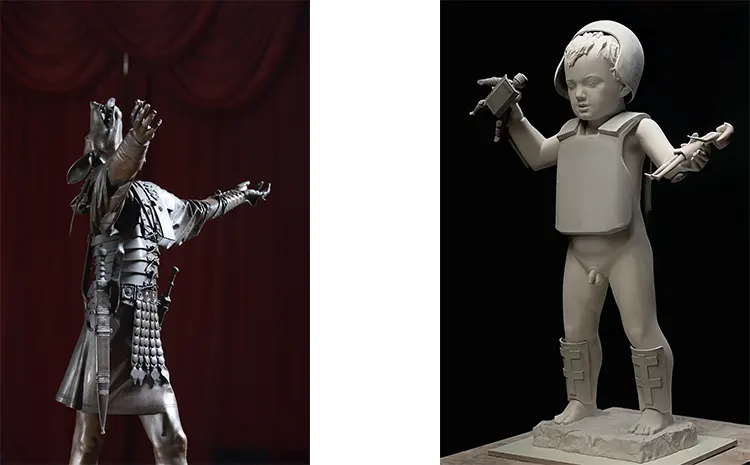
Pavel Kaltygin: Influences and Innovations
Pavel Kaltygin’s artistic vision is deeply rooted in a broad spectrum of influences, reflecting a rich tapestry of historical and contemporary art. Despite the challenge in pinpointing specific inspirations, Kaltygin acknowledges a select group of artists who have left an indelible mark on his work, including Giacomo Manzu, Hendrick Goltzius, Donatello, and Piero Della Francesca, among others. His admiration for these masters is not static but evolves as he delves deeper into specific themes or techniques, demonstrating a layered approach to artistic influence that mirrors his methodical process of creation. This eclectic array of influences speaks to Kaltygin’s commitment to exploring art in its myriad forms, from the sculptural language of ancient zodiac heads to the futuristic visions of Hajime Sorayama.
Kaltygin’s choice of medium further illustrates his innovative spirit. Initially drawn to bronze through his mentor’s preference, he embraced the material’s complexities, becoming intimately involved in every stage of the casting process. This hands-on approach allowed him to push the boundaries of traditional casting, refining techniques to achieve his artistic vision. The transition to working with porcelain, inspired by his move to Turkey and the rich ceramic traditions of Kutahya, represents another chapter in Kaltygin’s exploration of materials. His willingness to tackle the technical challenges of combining bronze and porcelain in large-scale sculptures underscores his dedication to innovation, blending tradition with contemporary themes and techniques. Through his work, Kaltygin not only pays homage to the artistic giants who have influenced him but also charts his own course, continually experimenting with materials, themes, and processes to create art that resonates with the complexities of the human experience.
